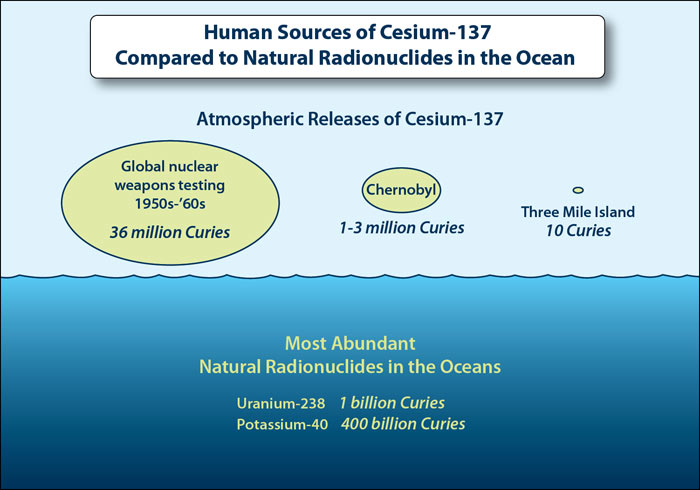Models are used to forecast the likely progression of radionuclides from Fukushima
Fukushima radiation could reach Pacific coast by April.
Fukushima radiation could reach Pacific coast by April.
From BBC
The likely scale of the
radioactive plume of water from Fukushima due to hit the west coast of
North America should be known in the next two months.
This will increase as contaminants disperse eastwards on Pacific currents.
But scientists stress that even the peak measurements will be well within the limits set by safety authorities.
The background level of radiation in oceans and seas varies around the globe.
Credit: WHOI
Credit: WHOI
Since the 2011 Fukushima accident, researchers from the Bedford Institute of Oceanography have been sampling waters along a line running almost 2,000km due west of Vancouver, British Columbia.
And by June of last year, they were detecting quantities of radioactive caesium-137 and 134 along the sampling line’s entire length.
Although the radioactivity concentrations remain extremely low – less than one becquerel per cubic metre of water – they have allowed the scientists to start to validate the two models that are being used to forecast the probable future progression of the plume.
Human sources of radiation released into the atmosphere over the past 60 years, although serious, pale in comparison to the radionuclides already naturally present in the ocean.
One of the most prevalent substances released through nuclear weapons testing, the accidents at Chernobyl and Three Mile Island, and now Fukushima, is cesium-137 (137Cs).
Total releases from Fukushima are currently above those at Three Mile Island, but below Chernobyl levels.
Among the dozens of radioactive substances naturally present in seawater (of which cesium-137 is one), uranium-238 and potassium-40 are the ones present in the greatest abundance.
Note: Ovals are not to scale. 1 Curie = 37 billion Becquerels.
Note: Ovals are not to scale. 1 Curie = 37 billion Becquerels.
(Illustration by Jack Cook, courtesy Coastal Ocean Institute, Woods Hole Oceanographic Institution)
One of these models anticipates a maximum concentration by mid-2015 of up to 27 becquerels per cubic metre of water; the other no more than about two becquerels per cubic metre of water.
Bedford’s Dr John Smith told BBC News that further measurements being taken in the ocean right now should give researchers a fair idea of which model is correct.
And he emphasised again: “These levels are still well below maximum permissible concentrations in drinking water in Canada for caesium-137 of 10,000 becquerels per cubic metre of water – so, it’s clearly not an environmental or human-health radiological threat.”
Dr Smith was speaking at the Ocean Sciences Meeting 2014 in Honolulu, Hawaii.
He was joined on a panel discussing Fukushima by Dr Ken Buesseler from the Woods Hole Oceanographic Institution.
The Whoi scientist described the citizen science effort now under way to record radioactivity in beach waters of the western United States. (see video)
Members of the public are being recruited to regularly gather water samples from California to Washington State and in Alaska and Hawaii.
WHOI chemist Ken Buesseler discusses radiation in the ocean
and the impacts of Fukushima across the Pacific--from Japan to North America
and the impacts of Fukushima across the Pacific--from Japan to North America
No caesium-134 has yet been detected.
Caesium-137, which was also released by the damaged power plant, is in the environment already as a result of the A-bomb tests in the 1950s and 1960s.
However, Dr Buesseler expects a specific Fukushima signal from both radionuclides to be evident very shortly in US waters.
Dr. Roger Gilbert collects seawater near Fort Bragg
in an effort to monitor for radiation contamination.
How radioactive is our ocean: current sample locations
ourradioactiveocean.org sampling project sampling project
“What we have to go by right now are models, and as John Smith showed these predict numbers as high as 30 of these becquerels per cubic metre of water,” he told reporters.
“It’s interesting: if this was of greater health concern, we’d be very worried about these factors of ten differences in the models. To my mind, this is not really acceptable. We need better studies and resources to do a better job, because there are many reactors on coasts and rivers and if we can’t predict within a factor of 10 what caesium or some other isotope is downstream - I think that’s a pretty poor job"
Links :
- WHOI : FAQ: radiation from Fukushima
- CSMonitor : Radioactive materials from Japan's Fukushima disaster reaches Canada, say scientists
- LiveScience : Fukushima's radioactive ocean water arrives at West Coast
- NYTimes : Worst spill in 6 months is reported at Fukushima
- CNN : Did Fukushima disaster make U.S. sailors and Marines sick?

No comments:
Post a Comment